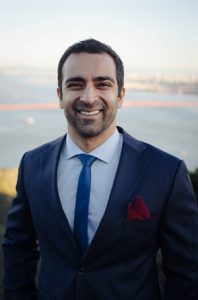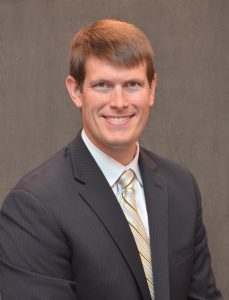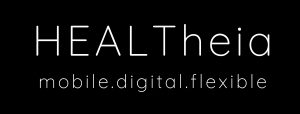S.K. Steven Houston III, MD has been working on telemedicine solutions since his vitreoretinal fellowship at Wills Eye Hospital in Philadelphia, PA. Dr. Houston’s attendings, Drs. Julia A. Haller and Jay L. Federman, have been developing telemedicine solutions for over a decade, and served as instrumental mentors to Dr. Houston and fueled his interest in pioneering novel telemedicine solutions in eye care.
Dr. Houston joined his practice at Florida Retina Institute in July 2015. He is a partner with the practice, and is one of 12 retina specialists. Florida Retina Institute has 10 offices in central Florida, seven in northern Florida and two offices in Georgia.
Even though telemedicine has been discussed, highlighted and hypothesized over the last several years, its progress in ophthalmology has moved at glacier speed. The ongoing impediments have included: regulations, lack of reimbursement and licensure to name a few. Currently, however, in other subspecialties like primary care, general medicine and endocrinology, there has been some traction with telemedicine, especially in rural areas, underserved communities, and nursing homes.
The COVID-19 pandemic has been a catalyst as the Centers for Medicare and Medicaid Services (CMS), accelerated telehealth coverage with an initial announcement on Friday, March 6. This was a watershed moment since many restrictions were lessened and now, telemedicine services could be billed and reimbursed at similar rates to in-office visits. These announcements have been pivotal in opening up innovative workflows and processes in the clinic to address the post-COVID-19 landscape as we begin our “new normal.”
Patients need to be safe when receiving medical care, but they must also feel safe. Patients are not comfortable with our old way (busy, packed waiting rooms and long wait times) in retina clinics, as evidenced by patients telling me, “I was really worried about coming in to the office, as I didn’t want to be exposed to many patients and wait in the waiting room for a long time. However, once I got here and saw the precautions you were taking, and the effort taken to get me in and out of the office in 20-30 minutes, I am comfortable coming back again. Thank you!” The harsh reality is that if we don’t change the way we all provide services, patients won’t want to venture out of the safety of their homes for their doctor’s appointment for the foreseeable future. We are already seeing the effect of patients’ hesitations, especially in the absence of an acute issue. I try to think about it from my own perspective. When would I be comfortable taking my family on vacation on an airplane or to sit down and eat in a restaurant? If the airlines continue to pack every seat full with no social distancing, and not requiring customers to wear masks, then I am going to postpone airplane travel in the “old way” until I feel safe. The same goes for eating in a packed indoor restaurant without regard for social distancing. Once I feel safe and comfortable, I may then consider resuming these activities in the post-COVID-19 era.
As ophthalmologists and retina specialists leap back into our “new normal,” we will have a huge surge of patients coming. Even if we work from 6 am to 10 pm, we will have difficulty catching up with the backlog of patients that have postponed care (our practice already has over a thousand postponed or rescheduled patients). The “old days” of a crowded waiting room with long wait times (average 60 to 120 minutes), and little regard for social distancing are no longer an option. We have instituted multiple precautionary procedures to decrease the number of patients/family in the clinic at a time, including patients waiting in their vehicles, restricting family from accompanying the patient, prioritizing injection patients and emergencies, and minimizing dilation for many patients. We have also decreased the clinic volumes to space out patients throughout the day. However, as clinic volumes start to increase as we add back in the chronic disease patients (dry AMD, diabetic retinopathy, etc), we must think about our old workflows and develop new innovative processes in clinic.
To address the above issues, we have started using telemedicine in a novel new way in order to continue our in-office practice, but supplement this with a parallel virtual clinic to allow for social distancing and minimizing the wait time in the office setting (with a goal of 30 minutes or less in clinic). Our new paradigm post-COVID-19 combines telemedicine with our advanced imaging technologies to enhance our processes and workflows with an aim to enhance safety and efficiency. My colleagues, Drs. Ehsan Rahimy, Palo Alto, CA and John B. Miller, Massachusetts Eye & Ear Infirmary, Boston, MA, and I have collaborated (via our company HealTheia) to develop Hybrid Tele-EyeCareTM(HyTECTM), which provides a new way for our patients to see their retina specialist. We’ve seen several hundred patients with HyTECTM and we have modified and improved our workflows during this time.


Ehsan Rahimy, MD John B. Miller, MD
Our experience has been very positive from the physician’s and patient’s perspective, with the comments from one patient emphasizing these changes: “I have been coming to the retina specialist for years. This visit was the easiest and most efficient ever. Why haven’t you been doing it this way before. Can I do all my visits moving forward in this way?”
With multiple office locations in our practice, we have several offices that are empty certain days of the week. We started with the initial question, “How do we utilize these empty offices?” to see patients that need to be seen. We didn’t have enough doctors to cover all these offices for additional days, so we rolled out HyTECTM initially to these locations. We schedule patients to come into an empty office that is staffed by one or two technicians. We schedule patients 15 minutes apart to try and keep only one patient in the office at a time. A single technician interacts with the patient for the entirety of the visit and performs a written consent for the telemedicine visit, then commences with the workup (including history, visual acuity, IOP, and NO dilation). The single technician then performs an SD-OCT and OPTOS wide-field imaging. Throughout the visit, the patient does not interact with any other staff or patients, and does not sit in the waiting room. Additionally, the patient is in and out of the office in 10 or 15 minutes. Patients have the option to virtually connect live with me from the office, or they can go home and connect virtually from the comfort of their home. I remotely access the medical record and imaging, and then I perform synchronous audio-visual communication with the patient to review findings, diagnosis, and treatment with the patient and/or family member via ZOOM Healthcare.
RL: Describe the telemedicine interaction between you and your patient.
SH: Initially, we only did virtual communications within 24 to 48 hours after the technician visit. However, this restricted access to patients that had internet, an email address, and a computer/smartphone/tablet. Many of our patient population does not have this access or cannot navigate these technologies. This led us to also offer the in-office live virtual communication. During the virtual component of this visit, I connect via audio-video conferencing app such as Zoom. I will verbally consent the patient for the telemedicine visit, then review the history and ask about any new symptoms. One reason I like more sophisticated platforms (such as Zoom, Google Hangouts, Microsoft Teams) over more basic ones (Doxy, FaceTime) is that the former allows me to share screen with the patient. As a result, I can easily show the patient their Optos images and OCTs, while highlighting with my mouse pointer areas of interest on the images. Less sophisticated platforms have a work-around by reversing the video camera and showing the patient the images on the physicians screen. However, there is no pointer, and the images are not as easily viewed. Part of the reason for using HyTECTM visits is to simulate an in-office visit and it is with advanced virtual platforms that we can provide an enhanced patient experience.
Hybrid Tele-EyeCareTM is ideal for stable, chronic disease patients, such as: dry AMD, diabetic retinopathy, ERMs, post-ops out of the post-op period, etc. With the current CMS guidelines, these virtual visits performed in this manner are reimbursed the same as in-office (using E/M codes and CPT codes for imaging).
RL: How did you manage patient expectations for their empty office visit?
SH: Prior to patients coming in for their first Hybrid Tele-EyeCareTM visit, my staff discusses what to expect with the patient. We highlight the key features that distinguish this from a regular office visit, including minimal staff and patient exposure, short visits (10-15 minutes), NO dilation, and virtual connection with the physician. We discuss the exact steps with the patient from arrival to departure. This ensures they understand the visit objectives and have the opportunity to ask questions before their appointment. When we first rolled out these visits, our staff asked patients if they were interested in a telemedicine visit without explaining the details. Not surprisingly, the majority of patients were not interested. It was only after we took the time to discuss the process, that they understood that this was more than just a video call with the physician, and that they would have all the same imaging as they are accustomed to receiving.
RetinaLink (RL): What patients are you seeing in your clinic?
SH: During the COVID-19 pandemic, we have been under an executive order in Florida. As a result, we have been prioritizing injection patients, emergencies, and patients with acute symptoms. As we saw flattening of the case curve, we started to slowly increase clinics, but with strict precautionary measures and social distancing, including offering more Hybrid Tele-EyeCareTM visits.
RL: What is your surgical and referral decrease and why do you believe this is happening?
SH: Like most other practices around the US, we have seen a decrease in volume during COVID-19 as a result of an executive stay-at-home order by the governor of Florida. Most optometry and ophthalmology practices in our community have only been seeing emergency patients, with a resultant decrease in referrals to retina. New patient numbers are significantly down, as many patients, especially many elderly patients, are fearful to leave their homes, even to go to a doctor’s appointment. Undoubtedly, this pandemic is creating a delay in medical care as patients postpone usual care and monitoring, and I am concerned that this will adversely affect patient outcomes. I have noticed that we have seen significantly less retinal detachments, something that others around the country have anecdotally noticed as well. I worry that there are significant number of patients that are not seeking an ophthalmic evaluation and instead staying at home and waiting it out. As a result, I anticipate a potential surge in vision-threatening diseases over the next few weeks as cities begin to open again.
RL: How did you develop the Workflows for your practice?
SH: With Drs. Rahimy and Miller, we have been working on telemedicine solutions and workflows for the past several years. As a result, when CMS changed their regulations on March 6th, we were ready to immediately institute our telemedicine solutions in our practices. I proposed the Hybrid Tele-EyeCareTM model to my partners at Florida Retina Institute, and they unanimously supported piloting these visits. Within the span of a week, our team established policies and procedures, remote access viewing, virtual technologies, and billing/coding policies. We saw our first patients the following week and we have now seen several hundred patients. With each week, I am working intimately with our telemedicine team to evolve the workflow and processes to enhance the experience for the patients, staff, and physicians.
RL: What are the key takeaways for telemedicine?
SH: The key takeaways include the following:
1) Image dependent – Wide-field imaging is critical. We utilize OPTOS in our practice. The image must be of excellent quality and reliably obtained. Optos has a very low ungradable image rate, less than 1%. As a result, I am confident in the imaging of the retina, not only of the macula and optic nerve, but also the periphery. Without wide-field imaging, I would not be comfortable with Hybrid Tele-EyeCare visits.
2) Workflow processes – Just having imaging technology in the offices and access to a video conferencing platform does not mean a practice is ready to go. This new workflow requires significant collaboration from different departments in a practice, from scheduling, technicians, physicians, billing/coding, information technology, to name a few. We have been working on these workflows for years, with many hurdles and difficulties along the way. Our experience allows us to assist others looking to start HyTECTM and help them avoid common pitfalls.
3) Remote access – Setting up cloud-based viewing, such as Optos Cloud Advance, or setting up a VPN to allow remote access to medical records, fundus imaging, and OCT.
4) Managing patient expectations – highlighting the reason for offering HyTECTM visits, namely to enhance safety and efficiency through an alternative model when paired with typical in-office visits.
5) Billing – Reimbursements for Hybrid Tele-EyeCareTM visits are equivalent to in-office E/M visits.
6) Virtual world – post-COVID-19 era will be heavily influenced by virtual connections. Telemedicine has been identified as the future in medicine. We can either be part of this change and create the workflows and processes to benefit our patients and us as physicians, or we can let someone else develop them for us. I’m for us developing them!
Telemedicine has been shown to be a viable solution for patients and even after the dust from COVID-19 settles, I believe that it will be here to stay for the future in all areas of medicine.
Dr. Steve Houston can be reached via e-mail – [email protected]
Dr. Ehsan Rahimy can be reached via e-mail – [email protected]
Dr. John Miller can be rached via e-mail – [email protected]
Contact us at www.HealTheia.com if you are interested in talking with us about Hybrid Tele-EyeCare (HyTEC)TM and how you can get started in your clinics.


